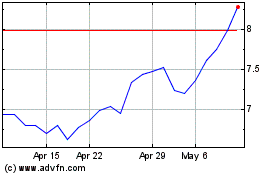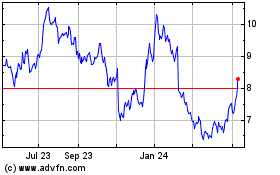The Shipping Industry Sends a Trade Warning
November 14 2018 - 12:27PM
Dow Jones News
By Jon Sindreu
Key global trade indicators are starting to flash red. This
time, it may be for the right reasons.
A.P. Moller--Maersk Group, the world's largest containership
operator, on Wednesday reported slower than expected unit growth in
its core shipping division during the third quarter. Higher fuel
prices are also squeezing the company's margins, though its
acquisition of the Hamburg Süd container fleet helped boost overall
profits.
The Danish conglomerate moves 18% of the world's containers and
is often seen as a bellwether for world trade, which is currently
under threat by the prospect of a global economic slowdown and the
Trump administration's protectionist policies. Shipping and
logistics companies like Maersk, Hapag-Lloyd and Deutsche Post --
owner of DHL Express -- have all been forced to issue profit
warnings this year, and third-quarter results have confirmed a
darker outlook.
It's still early, but this should nonetheless concern money
managers. While the U.S. economy remains strong, weakening trade
could signal further trouble in China, which would particularly
endanger Europe and emerging markets.
For many years, analysts tried to take the pulse of the global
economy by using the Baltic Dry Index, a figure issued daily by the
London-based Baltic Exchange that tracks the cost of dry-bulk cargo
ships. But after 2014 this index became unreliable, falling even as
global growth powered ahead.
The index gave false readings mainly because of shipping
companies' woes. In 2009 those firms launched something of an arms
race, buying larger vessels in an attempt to lower unit costs and
thereby profit from economies of scale. It was a trap: According to
an analysis by research firm Drewry, megaships trimmed costs less
than expected because ports had difficulty dealing with them. They
were also harder to dispose of when no longer needed.
The excess capacity depressed freight rates for years. Now the
index is trending down again -- but this time demand, not supply,
is the driver.
Drewry's updated forecasts suggest growth in port throughput, a
measure of demand, will fall below fleet growth by year end. This
is happening even after consolidation in the shipping sector, as
well as efforts by operators to cut the size of their fleets; new
orders are now mostly made up of smaller vessels. A profitable 2017
led to high hopes for 2018, but the industry seems set to lose
money again.
This time around, investors should pay attention to the warning
flag being hoisted by the global shipping industry.
Write to Jon Sindreu at jon.sindreu@wsj.com
(END) Dow Jones Newswires
November 14, 2018 12:12 ET (17:12 GMT)
Copyright (c) 2018 Dow Jones & Company, Inc.
AP Moller Maersk AS (PK) (USOTC:AMKBY)
Historical Stock Chart
From Aug 2024 to Sep 2024

AP Moller Maersk AS (PK) (USOTC:AMKBY)
Historical Stock Chart
From Sep 2023 to Sep 2024
